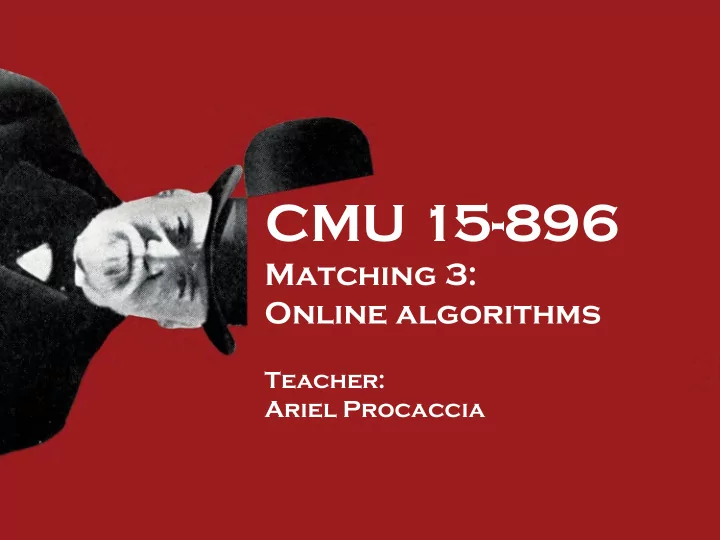

CMU 15-896 Matching 3: Online algorithms Teacher: Ariel Procaccia
Display advertising • Display advertising is the largest matching problem in the world • Bipartite graph with advertisers and impressions • Advertisers specify which impressions are acceptable — this defines the edges • Impressions arrive online 15896 Spring 2016: Lecture 15 2
The (simplest) model • There is a bipartite graph , is known “offline”, the vertices of arrive • online (with their incident edges) • Objective: maximize size of matching • ALG has competitive ratio if for every graph and every input order of , 15896 Spring 2016: Lecture 15 3
Algorithm GREEDY • Algorithm G REEDY : match to an arbitrary unmatched neighbor (if one exists) Poll 1: Competitive ratio of G REEDY ? 1. 2. 3. 4. 15896 Spring 2016: Lecture 15 4
Upper bound • Observation: The competitive ratio of any deterministic algorithm is at most � � � � 15896 Spring 2016: Lecture 15 5
Take 2: Algorithm RANDOM • Obvious idea: randomness • Algorithm R ANDOM : Match to an unmatched neighbor � uniformly at random 2 • Achieves on previous example � Competitive ratio of R ANDOM 2 on graph on the right? 15896 Spring 2016: Lecture 15 6
Take 3: Algorithm RANKING • Algorithm R ANKING : Choose a random permutation o �: � → � � Match each vertex to its unmatched o 2 neighbor � with the lowest � � • Looks like this is doing better than R ANDOM on previous example! � • Theorem [Karp et al. 1990]: The 2 competitive ratio of R ANKING is 15896 Spring 2016: Lecture 15 7
Proof of theorem • Assume for ease of exposition that OPT ∗ • Fix a perfect matching • Fix and • If is matched under , is a match event at position , otherwise miss event • ALG is the sum of probabilities of match events at all positions 15896 Spring 2016: Lecture 15 8
Proof of theorem � induces a matching • � � ∗ • Consider a miss event ∗ with � � � � � ∗ � ∗ ∗ , ∗ ∗ � � ∗ • ∗ to • Define � by moving � ∗ position � ∗ � ∗ � � ∗ • Claim: for each , � with � � 15896 Spring 2016: Lecture 15 9
Proof of theorem • Proof of claim: by illustration � ∗ � ∗ � ∗ � ∗ � ∗ � ∗ � ∗ � ∗ � � � � � ∗ � ∗ � � � � � ∗ � ∗ � � � � � � � � � ∗ � ∗ � ∗ � ∗ � � � � 15896 Spring 2016: Lecture 15 10
Proof of theorem • We have a - mapping between miss events ∗ and match events where � � ∗ and � � ∗ ∗ � � � • Claim: Each miss event at position is mapped to unique match events • Proof of claim: Fix miss events ��, �� and �� � , � � � such that o � � � � � �� � � � � , and both are mapped to �� �, � �� � � � � � ∗ � � � ∗ � � ⇒ � � �′ � � o The map only moves � from position � in � and � � , o � in both cases ⇒ � � � � ∎ giving � 15896 Spring 2016: Lecture 15 11
Proof of theorem • We get the following set of equations for every ��� • Setting � , this is � � ��� • By minimizing the objective function over � � � this polytope, we get � � � 15896 Spring 2016: Lecture 15 12
Upper bound • Theorem [Karp et al. 1990]: No randomized alg � has competitive ratio better than � • The proof below is due to Wajc [2015] • Fractional algorithm: deterministically assign fractional weights to edges such that s.t. �� �,� ∈� • Lemma [Wajc 2015]: For any randomized alg there is a fractional alg with at least the same competitive ratio 15896 Spring 2016: Lecture 15 13
Proof of theorem • First online vertex � is 1/5 � � � � � � � � connected to all 1/5 • Let � , in �∈� 2/5 particular � 1/5 � will not be connected to any • future online vertex 15896 Spring 2016: Lecture 15 14
Proof of theorem -th online vertex � is • � � � � � � � � connected to all � ��� � � � � • � �∈�∖ � � ,…,� ��� � will not be connected to • any future online vertex 15896 Spring 2016: Lecture 15 15
Proof of theorem Poll 2: What is OPT? 1. � 2. � 3. 4. 15896 Spring 2016: Lecture 15 16
Proof of theorem • After step , offline vertices that continue to be matched are matched to an average of at least � � ��� ����� • Following the arrival of the -th online vertex � with , it holds that offline � vertices that will neighbor future online vertices are matched to an average of � ��� � �� � � � � � 1 � � 1 1 ln��� � ln � � � � � � � � � 1 ��� ��� � 15896 Spring 2016: Lecture 15 17
Proof of theorem � � • So at step , , but � ����� ��� because for all , this means that for all � • That is, the algorithm cannot match the vertices ��� � � • ALG � 15896 Spring 2016: Lecture 15 18
Recommend
More recommend